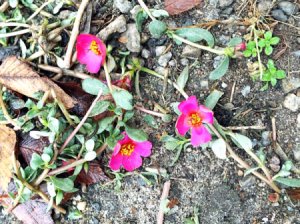 Yes, those are Portulaca umbraticola. Mine grow so thickly, I find myself thinning them every year. Here are some thinnings I haven't yet picked up and taken to the compost pile.
Yes, those are Portulaca umbraticola. Mine grow so thickly, I find myself thinning them every year. Here are some thinnings I haven't yet picked up and taken to the compost pile.
Anything special here? Indeed there is! The Life Force. Within these plant's programs are instructions to make seed so that the program, itself, will continue.
These thinnings were ripped from their bed five days ago. Since that time, they have had no food nor water. Even during their slow, but inevitable death, their programs continue to play. They will do so til the very last.
At day five, one program still very active in these plants, is for the blooms to open and close several times a day, triggered by the changes in intensity of light.
So, without food or water, or even a root system, the will to survive and procreate is very much alive in these dying plants. How is that?
If we knew everything, there would be no mysteries, life would be very boring.
What is life?
Life is a program. Consciousness is that instrument on which the program is played.
But then, Consciousness is a program, too.
You knew that, didn't you?
Check out these photos.
Purslane, a type of portulaca, was the scourge of the 17th, 18th, and 19th century European gardener. They detested it so, they gave it names like 'Pusley' and Hogweed, no doubt they fattened many a hog on this stuff.
There are several different kinds of Portulaca. Probably the most often grown by the home gardener is Portulaca pilosa. It's common name is Moss Rose. With a 25¢ pack of seed from a local dollar store, you can have a pretty, multi colored display of low growing, almost carefree flowers from Spring to late Fall.
I have a row of these stunning fuchsia beauties that open each morning along my walk. They create a beautiful splash of color to anyone who happens to come along.
There are so many varieties of portulaca, I get confused. Understandable, as the taxonomists don't always agree on what's what in this Portulacaceae family. If I'm not mistaken, here, I am growing Portulaca Grandiflora, commonly known as 'Moss Rose'.
Portulaca oleracea, also called moss rose, used to grow everywhere: sidewalk cracks, old logs, piles of rotting leaves, and in the front-yard flower beds of every home on our block.
ThriftyFun is one of the longest running frugal living communities on the Internet. These are archives of older discussions.
This are my beautiful May flowers. I love rose moss and grow lots of it every year.